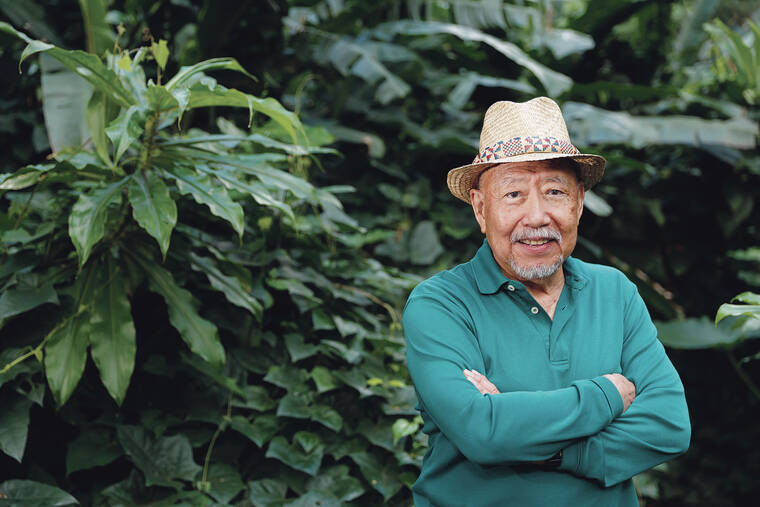Ask actor Dann Seki how old he is and he’ll tell you short and sweet: “70+.”
Ask what keeps him active and engaged in life these
days and the answer is more complicated.
“I help with the FIRST (For
Inspiration and Recognition of Science and Technology) Robotics regional competition as part of the announcing team. I serve on the boards of Kumu Kahua Theatre and the Honpa Hongwanji Hawaii Betsuin. I do lauhala weaving. I recently joined a bon dance taiko group that plays at various bon dances during the summer, and I recently began helping with props at Kuma Kahua,” Seki said recently, enjoying a cup of coffee at Starbucks in the Aiea Shopping Center.
The coffee shop is a convenient hangout. Seki is a lifelong Aiea resident except for the four years he was in the Army. He lives in the house he grew up
in and is a member of the first graduating class of Aiea High School (Class of ’64).
In professional terms, Seki is most visible at the moment as the star of “Shikata Ga Nai,” a contemporary island drama
released by the Hawaii-based Yellow Brick Studio film and video production company.
Eric Nemoto, the film’s
writer, director and producer, approaches the familiar subject of Japanese Americans in the racially segregated 100th Infantry Battalion and 442nd Regimental Combat Team. The story follows two fictional 442nd veterans, Tats Kaneshiro and Seichi Mochizuki, living in Hawaii 50 years after the war ended. Both men were participants in the 442nd team’s famed rescue of the “Lost Battalion” in the Vosges Mountains in 1944; Kaneshiro has been struggling with undiagnosed post-traumatic stress disorder ever since.
Seki stars as Kaneshiro. Allan Okubo is Mochizuki.
“It’s a great role. Eric (Nemoto) wrote it well,” Seki said. “A lot of the veterans who were in World War II are no longer with us, and so we can’t really get their feedback in terms of saying, ‘Can you share some of your stories?’
because they’re all gone.
“Talking to their kids, ‘Did Dad share anything with you? Did Uncle share anything with you?’ For most of the kids — including me, my dad was in the 100th Battalion — the answer is no, they never
really talked about their experiences. You look at the people who came back from Afghanistan, and we have to assume that the World War II guys, and even the World War I guys, came back with the same kind of things but they never talked about them.”
“Shikata Ga Nai” is the latest entry in Seki’s career in film, stage, television and radio that began in the 1980s with four years as a DJ and newscaster on KORL radio, speaking roles in the original “Magnum, P.I.” and the adventure movie “Savage Beach,” and as Tosh Kamiya in Kumu Kahua’s 1989 staging of “Manoa Valley.”
Local film buffs also remember Seki as the star of the 2006 Hawaii International Film Festival trailer.
“Having to memorize and say the lines are things that keep the brain going. And then moving around on set, whether it’s a play or a movie, keeps the body moving,” Seki said of his work. “People say, ‘How do you remember all those lines? Why not just muddle through it?’ There are times when you do forget, hopefully not on stage, but that keeps the mind
going too, because you have to ‘tap dance’ and pivot, kind
of figure out where you are or where you should be.
“That’s the advantage, or disadvantage, I suppose, of working on live stage because you have to keep going, regardless of what happens. The advantage of movies and TV is that the director can always yell, ‘Cut! Do it again!’”
This year, Seki is taking a break from stage work to be with family. His grandson in California is graduating from high school in May, so he’ll be out of town when Oahu’s local theater groups are presenting their spring shows and holding auditions for future productions. The trip will also give him in-person time with his granddaughter, an engineering major in her first year of college.
Talking with young people keeps an older person young, he said.
“You can talk to them as adults, so to speak, and listen to their younger point of view, which does not necessarily agree with what we’re thinking, but we have to keep up to date on culture and things that are going on, like video games and stuff like that, so we can have an intelligent conversation with them,” he said.
“My granddaughter is in engineering. That’s way over our heads, so we’ll talk about her social life.”




